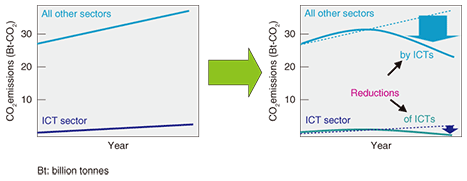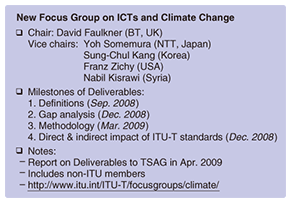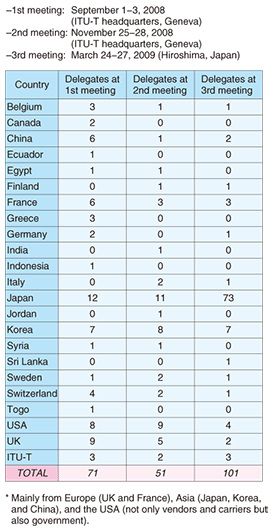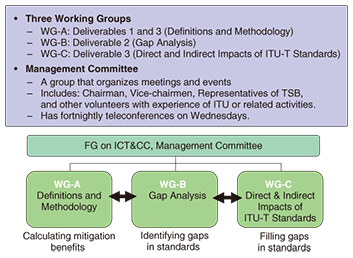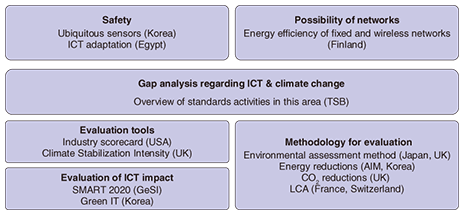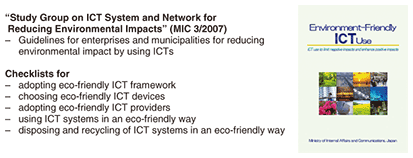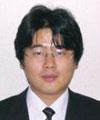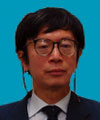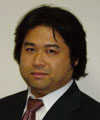 |
|||||||||||||||
|
|
|||||||||||||||
|
Global Standardization Activities Vol. 7, No. 9, pp. 30–36, Sept. 2009. https://doi.org/10.53829/ntr200909gls Standardization Activities on ICTs and Climate Change in ITU-TAbstractThis article reviews standardization activities at the International Telecommunication Union, Telecommunication Standardization Sector (ITU-T) related to information and communications technologies (ICTs) and climate change. With global warming becoming a serious concern, ITU-T established a Focus Group in July 2008 to address standardization related to the impact of ICTs on climate change, in particular the reduction of ICTs’ own emissions over their entire lifecycles and the mitigation due to the adoption of ICTs in other relevant sectors. This article outlines discussions to date, describes recent progress, and introduces the future structure of such standardization activities in ITU-T.
1. ITU-T symposia on ICTs and climate changeThe United Nations Intergovernmental Panel on Climate Change (IPCC) foresees a further rise of between 1.4 and 5.8¡ëC in average global temperatures by the end of the century. Climate change is a concern for everyone and requires efforts on the part of all sectors of society, including the information and communications technology (ICT) sector. Although ICTs contribute only an estimated 2.5% of total greenhouse gases, this is expected to grow as ICT usage expands globally, growing at a faster rate than the general economy. ICTs are thus part of the cause of global warming; however, they can also be part of the solution, e.g., through the promotion of carbon displacement technologies. Namely, ICTs are expected to reduce their own emissions over their entire lifecycles and mitigate global warming through their adoption in other relevant sectors to enhance the efficiency of energy use, reduce the movement of people and goods, and so on (Fig. 1).
To stress the energy-saving contributions of using ICT services and the need for an internationally agreed common methodology for measuring the environmental impact of ICTs on climate change, the International Telecommunication Union, Telecommunication Standardization Sector (ITU-T) held the Kyoto Symposium in April 2008 and the London Symposium in June 2008 on ICTs and Climate Change (ICT&CC). The Kyoto Symposium recognized the importance of energy-saving contributions by ICT services, the need for an internationally agreed common methodology for measuring the environmental impact of ICTs on climate change, and the need for a new Focus Group (FG). As a result of the London Symposium, the need to investigate the following three points was declared as a step toward resolving the issue of global warming: (1) Energy consumption of ICT equipment; (2) Efficiencies to be gained through the use of ICTs in other sectors; and (3) Need for behavioral change by both businesses and consumers. In addition, there was a proposal to establish an FG for promptly standardizing an internationally agreed common methodology for measuring the reduction in CO2 emissions achieved by ICTs. 2. FG on ICT&CCAfter these two symposia, Japan and the UK led the way and proposed to the Telecommunication Standardization Bureau (TSB) the establishment of a new FG and terms of reference (ToR). As a result of discussions at the Telecommunication Standardization Advisory Group (TSAG) meeting of ITU-T held in July 2008, a new FG on ICT&CC was established (Fig. 2). Its main ToR items are given below.
(1) Scope: The FG will identify from the standardization viewpoint, within the competences of ITU-T, the impact of ICTs on climate change, in particular the reduction of ICTs’ own emissions over their entire lifecycles (direct impact), the mitigation due to the adoption of ICTs in other relevant sectors (indirect impact), and the monitoring of relevant climate parameters. (2) Objectives: The FG should analyze and identify gaps in the areas of definitions, general principles, methodology, and appropriate tools for characterizing the impact of ICTs on climate change and support the development of appropriate international standards. (3) Specific tasks and Deliverables (Ds): D1. Definitions:
D2. Gap analysis:
D3. Methodology:
D4. Direct and indirect impact of ITU-T standards:
3. Summary of FG meetingsThe FG used remote collaboration (through teleconferences, email exploder, and websites [1]) to the maximum extent as an alternative to face-to-face meetings in order to minimize its own emissions and to reduce the impact on its budget. As shown in Table 1, the FG held three well-attended physical meetings (September 1–3 and November 25–28, 2008 in Geneva and March 24–27, 2009 in Hiroshima) as well as 28 teleconferences.
At the first meeting in September 2008, three Working Groups (WGs) were established and several editors were appointed for each WG to handle the discussion (Fig. 3). A management committee consisting of the FG chairman and vice-chairmen, TSB, and the editors was formed to manage the operation of the FG smoothly. At the meeting, most contributions and presentations from countries and organizations were introductions of their current activities related to ICT&CC. A Living List including future work items and progress reports was made for each Deliverable. The original draft of each Deliverable report was also presented.
The second meeting in November 2008 discussed the way to edit contributions interconnected with relevant Deliverables and the draft report of each Deliverable. A decision was made to draw up an Executive Summary report (summary of each Deliverable). Moreover, the completion of the reports for Deliverables 1, 2, and 4 by December 2008 was confirmed, and the work schedule until the final meeting (March 2009) was confirmed. The third (final) meeting was held in Hiroshima, Japan, in March 2009. Future work arising from the Deliverables reports was discussed. The final reports and the Executive Summary reports for all Deliverables were completed by the end of March 2009. The main results of the Deliverables were as follows. D1. Definitions: The aim of work under D1 was to reach consensus on those key definitions that would be needed for work on methodologies under D3. Definitions of units of energy and efficiency were highlighted as keys. Standards development organizations (SDOs) with relevant definitions that were considered included ITU, IPCC, and the International Organization for Standardization (ISO). D2. Gap analysis: A gap analysis was performed under D2 to identify existing standards that are relevant to ICTs and climate change so as to avoid unnecessary work. ISO 14040:2006, 14064:2006, 14065:2007, and 14044:2006 were cited as key source methods. Various gaps were identified in the baseline text, some of which could be addressed by ITU. D3. Methodology: D3 aims to provide an internationally agreed method of calculating two elements: (1) the energy usage and carbon impact arising from the lifecycles of ICTs and (2) the mitigation that can be achieved through dematerialization and by substituting ICT services and devices for intensive fossil-fuelled activities such as travel and transport. This work has an important bearing on current and future global agreements under which countries make commitments to reduce their overall greenhouse gas emissions. The work on methodologies under D3 is central as it aims to provide a standard method of calculating the potential benefits of mitigation due to ICTs. The baseline text for D3 also relies on the definitions found in D1. D4. Direct and indirect impacts of ITU-T standards: Under D4, the FG investigated what tools (e.g., checklists) and guidelines would enable ITU-T SGs to reduce direct greenhouse gas emissions from ICTs and establish possible savings in terms of mitigation due to the use of ICTs. General checklists for eco-friendly use of ICT systems and services were introduced, and examples of networks and systems that influence climate change in the ICT field were discussed. ITU-T standards that have a positive impact on climate change mitigation were also explained. Note that the list of technologies and ITU-T standards introduced under D4 does not limit the possible and potential ICT technologies and ITU-T standards that impact climate change. 4. Contributions from each countryThe contributions from each country are summarized in Fig. 4 and outlined below.
4.1 Contributions from countries other than Japan
4.2 Contributions from JapanJapan submitted 13 contributions, considering the standardization of the internationally agreed methodology for calculating the environmental impact of ICT as a high-priority issue and centered on D3. Some of these contributions are outlined below. The basic concept of Japanese contributions submitted in connection with D3 is shown in Fig. 5. The purpose of standardizing the calculation method, which is based upon the Japanese standardized “Guideline for ICT Eco-Efficiency Evaluation” [4], [5], is to enable ICT users to quantitatively show their contribution when they use ICTs so that they can include the contribution in their energy reduction activities. Standardizing the calculation method can clarify the contribution of the ICT sector in other sectors. This will make it possible to study specific measures using ICTs to combat global warming.
One goal of D4 was to develop tools and guidelines for energy saving through the use of ICTs. Therefore, as a contribution for D4, Japan submitted a handbook [6] that the Ministry of Internal Affairs and Communications (MIC) of Japan has developed for corporations and organizations that use ICT systems with the aim of providing guidelines and advice for limiting the negative impacts while enhancing the positive impacts on the environment when ICT systems are introduced, operated, and disposed of (Fig. 6).
A goal of D2 was a gap analysis of the energy-saving measures on the basis of the ongoing activities inside and outside ITU-T. Therefore, Japan introduced a report of the “Study Group on ICT Policies for Resolving Global Warming Problems” (MIC, April 2008), which includes various activities related to ICT&CC in the world and analysis measures, calculation methods, and approaches. It describes expectations for ITU-T to settle appropriate criteria and indexes, and it clarifies energy consumption and savings, in terms of the corresponding CO2 emissions, estimated to be achieved by ICTs. That is, 30 megatonnes (Mt) of CO2 are estimated to be emitted in Japan by 2012 by ICT equipment. However, 68 Mt-CO2 are expected to be saved by using ICT services; therefore, ICTs will contribute a saving of 38 Mt-CO2 to CO2 emission reduction efforts. Moreover, it reports an ICT policy to help address global warming issues while clarifying the impact of ICTs on global warming. 5. Outlook after FGThe results of FG-ICT&CC Deliverables were reported at the latest TSAG meeting in April 2009 and that meeting approved the establishment of the new SG5 on “Environment and Climate Change”. In the future, study items closely related to those covered by existing SGs will be assigned to the existing Questions under the respective SGs. References
|
|||||||||||||||








